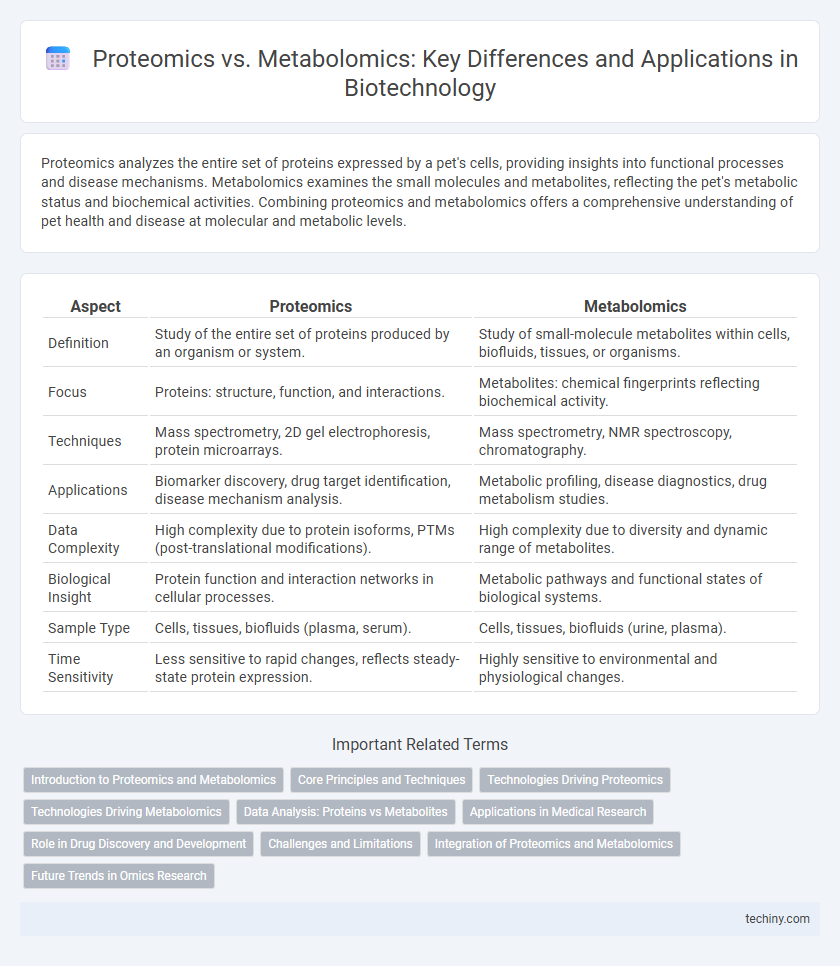Proteomics analyzes the entire set of proteins expressed by a pet's cells, providing insights into functional processes and disease mechanisms. Metabolomics examines the small molecules and metabolites, reflecting the pet's metabolic status and biochemical activities. Combining proteomics and metabolomics offers a comprehensive understanding of pet health and disease at molecular and metabolic levels.
Table of Comparison
| Aspect | Proteomics | Metabolomics |
|---|---|---|
| Definition | Study of the entire set of proteins produced by an organism or system. | Study of small-molecule metabolites within cells, biofluids, tissues, or organisms. |
| Focus | Proteins: structure, function, and interactions. | Metabolites: chemical fingerprints reflecting biochemical activity. |
| Techniques | Mass spectrometry, 2D gel electrophoresis, protein microarrays. | Mass spectrometry, NMR spectroscopy, chromatography. |
| Applications | Biomarker discovery, drug target identification, disease mechanism analysis. | Metabolic profiling, disease diagnostics, drug metabolism studies. |
| Data Complexity | High complexity due to protein isoforms, PTMs (post-translational modifications). | High complexity due to diversity and dynamic range of metabolites. |
| Biological Insight | Protein function and interaction networks in cellular processes. | Metabolic pathways and functional states of biological systems. |
| Sample Type | Cells, tissues, biofluids (plasma, serum). | Cells, tissues, biofluids (urine, plasma). |
| Time Sensitivity | Less sensitive to rapid changes, reflects steady-state protein expression. | Highly sensitive to environmental and physiological changes. |
Introduction to Proteomics and Metabolomics
Proteomics involves the large-scale study of proteins, their structures, functions, and interactions within biological systems, enabling insights into cellular processes and disease mechanisms. Metabolomics examines the comprehensive profile of metabolites, small molecules that are the end products of cellular metabolism, reflecting the physiological state of an organism. Both fields utilize advanced technologies like mass spectrometry and chromatography to analyze biological samples, offering complementary perspectives for biomarker discovery and systems biology.
Core Principles and Techniques
Proteomics centers on the large-scale study of proteins, emphasizing their structures, functions, and interactions through techniques like mass spectrometry and two-dimensional gel electrophoresis. Metabolomics analyzes small-molecule metabolites within cells, tissues, or organisms, employing chromatography coupled with mass spectrometry or nuclear magnetic resonance spectroscopy to profile metabolic changes. Both fields use advanced bioinformatics for data integration, but proteomics focuses on protein expression dynamics while metabolomics reveals functional biochemical pathways.
Technologies Driving Proteomics
Advancements in mass spectrometry and protein microarrays are central to technologies driving proteomics, enabling precise identification and quantification of proteins in complex biological samples. Techniques such as tandem mass tags (TMT) and data-independent acquisition (DIA) enhance throughput and accuracy in proteome profiling. These innovations contrast with metabolomics, which primarily utilizes nuclear magnetic resonance (NMR) and gas chromatography-mass spectrometry (GC-MS) to analyze small-molecule metabolites.
Technologies Driving Metabolomics
Advanced mass spectrometry (MS) and nuclear magnetic resonance (NMR) spectroscopy technologies are driving metabolomics by enabling precise identification and quantification of small molecules in complex biological samples. High-resolution MS, coupled with chromatography techniques such as gas chromatography (GC) and liquid chromatography (LC), enhances sensitivity and throughput in metabolite profiling. Integration of computational tools and machine learning further optimizes data analysis, allowing accurate metabolic pathway mapping and biomarker discovery.
Data Analysis: Proteins vs Metabolites
Proteomics data analysis involves identifying and quantifying thousands of proteins through mass spectrometry, focusing on peptide fragmentation patterns and protein post-translational modifications. In contrast, metabolomics data analysis centers on detecting small molecule metabolites using techniques like NMR and LC-MS, emphasizing metabolic pathway mapping and metabolite concentration changes. Both fields require advanced bioinformatics tools, but proteomics often deals with larger, more complex datasets due to protein diversity, while metabolomics analyzes a broader chemical space with dynamic range variations.
Applications in Medical Research
Proteomics enables the identification and quantification of proteins, facilitating biomarker discovery and therapeutic target validation in diseases such as cancer and neurodegenerative disorders. Metabolomics provides a comprehensive analysis of metabolites, offering insights into cellular metabolic states and pathways critical for disease diagnosis and prognosis, especially in metabolic syndromes and cardiovascular conditions. Integrating proteomics and metabolomics accelerates personalized medicine by revealing molecular mechanisms underlying pathologies and optimizing treatment strategies.
Role in Drug Discovery and Development
Proteomics provides insight into protein expression, interactions, and modifications, enabling identification of drug targets and biomarkers crucial for drug efficacy and safety. Metabolomics analyzes metabolic changes and pathways, offering a dynamic snapshot of physiological states that aids in understanding drug mechanism of action and toxicology. Integration of proteomics and metabolomics accelerates drug discovery by revealing comprehensive molecular responses, enhancing precision medicine approaches and biomarker validation.
Challenges and Limitations
Proteomics faces challenges such as protein complexity, dynamic range, and post-translational modifications that complicate identification and quantification, while metabolomics struggles with the vast chemical diversity and instability of metabolites, limiting comprehensive profiling. Both fields require advanced analytical techniques like mass spectrometry and face data interpretation difficulties due to large, complex datasets. Incomplete databases and the lack of standardized protocols further hinder reproducibility and cross-study comparisons in proteomics and metabolomics research.
Integration of Proteomics and Metabolomics
Integration of proteomics and metabolomics enhances the comprehensive understanding of cellular processes by correlating protein expression with metabolite profiles. Advanced analytical techniques such as mass spectrometry and bioinformatics tools enable the simultaneous analysis of proteins and metabolites, revealing dynamic biochemical pathways and regulatory networks. This multi-omics approach accelerates biomarker discovery, systems biology research, and precision medicine by providing a holistic view of organismal function at molecular levels.
Future Trends in Omics Research
Proteomics and metabolomics are rapidly evolving fields within omics research, driving personalized medicine and biomarker discovery. Advances in high-throughput technologies and AI-powered data integration are expected to enhance the resolution and interpretability of protein and metabolite profiles. Future trends emphasize multi-omics approaches, combining proteomic, metabolomic, transcriptomic, and genomic data to unravel complex biological systems and accelerate drug development.
Proteomics vs Metabolomics Infographic

 techiny.com
techiny.com